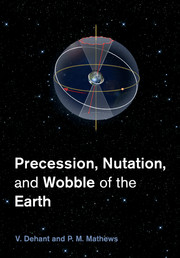Book contents
- Frontmatter
- Contents
- Preface
- List of abbreviations
- 1 Introduction – Fundamental definitions – Motivation
- 2 Concepts and elementary theory
- 3 Reference systems and frames
- 4 Observational techniques – ephemerides
- 5 Rigid Earth precession and nutation
- 6 Deformable Earth – Love numbers
- 7 Nutations of a non-rigid Earth
- 8 Anelasticity
- 9 Ocean and atmospheric corrections
- 10 Refinements of non-rigid nutation
- 11 Comparison observation-theory
- 12 Conventions
- 13 Mars nutations
- Appendix A Rotation representation
- Appendix B Clairaut theory
- Appendix C Definitions of equinoxes
- Bibliography
- Index
13 - Mars nutations
Published online by Cambridge University Press: 05 May 2015
- Frontmatter
- Contents
- Preface
- List of abbreviations
- 1 Introduction – Fundamental definitions – Motivation
- 2 Concepts and elementary theory
- 3 Reference systems and frames
- 4 Observational techniques – ephemerides
- 5 Rigid Earth precession and nutation
- 6 Deformable Earth – Love numbers
- 7 Nutations of a non-rigid Earth
- 8 Anelasticity
- 9 Ocean and atmospheric corrections
- 10 Refinements of non-rigid nutation
- 11 Comparison observation-theory
- 12 Conventions
- 13 Mars nutations
- Appendix A Rotation representation
- Appendix B Clairaut theory
- Appendix C Definitions of equinoxes
- Bibliography
- Index
Summary
As we have seen in the previous chapters, the Earth undergoes precession, nutation, and wobble due to gravitational pulls of other objects of the solar system (such as the Sun and the Moon) because of its rotation, its equatorial bulge, and the 23.5° obliquity of its orbit. However, the Earth is not the only planet having precessional and nutational motions. Mars in particular is also rapidly rotating, has an equatorial bulge, and its mean orientation is tilted with respect to the ecliptic (the obliquity of Mars is about 25°). Therefore Mars also changes its orientation in space.
Rotation and obliquity of Mars
Mars is at present in the situation where the obliquity is around 25°. According to long-term studies of Mars' orbital and orientation evolution theory (Laskar et al., 2002, 2004), the obliquity of Mars fluctuated between about 15 and 35° over the last million years and has a chaotic behavior on long timescales. The present situation is thus very interesting as it is incidentally very close to the situation of the Earth.
One solar day of Mars is around 24h 40min, thus corresponding to a rapid rotation very similar to that of the Earth. In the first approximation, Mars is in hydrostatic equilibrium and, due to its rotation, has an equatorial bulge; the equatorial radius is about 9 km larger than the polar radius, less (as Mars is smaller than Earth) than the 21 km of difference between the Earth's equatorial radius and polar radius.
Mars being a terrestrial planet (a rocky planet composed primarily of silicate rocks or metals) its interior is very similar to the interior of the Earth, with a mantle and a core believed to be liquid as deduced from first estimations of the tidal Love number k measured by spacecraft orbiting around Mars at present (Konopliv et al., 2006, 2011). We do not know whether there is an inner core inside the liquid core of Mars as there is for the Earth.
- Type
- Chapter
- Information
- Precession, Nutation and Wobble of the Earth , pp. 454 - 464Publisher: Cambridge University PressPrint publication year: 2015
- 1
- Cited by



